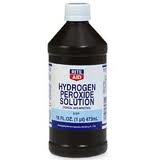
As far back as the early nineteenth century, hydrogen peroxide was widely used in medicine. Many bacterial diseases (including syphilis) responded to H2O2 when no other treatment was effective. In the early twentieth century, H2O2 was used to treat several common diseases, such as whooping cough, cholera, typhoid fever, ulcers, tuberculosis, and asthma. However, as the pharmaceutical industry began to develop expensive, new drugs, hydrogen peroxide was increasingly ignored and finally discarded as a treatment.
H2O2 stimulates natural killer (NK) cells, which attack cancer cells as they attempt to spread throughout the body. In the body’s immune response, hydrogen peroxide is released by T-cells to destroy invading bacteria, viruses and fungi. Blood platelets release hydrogen peroxide on encountering particulates in blood. In the large intestine, acidophilus lactobacillus produces H2O2 which keeps the ubiquitous candida yeast from multiplying out of control. When candida spreads out of the intestine, it escapes the natural control system and can gain a foothold in the organs of the body, causing what is called chronic fatigue syndrome.
During flu season, if the kiddos feel like they’re getting sick, we lay them down on their side and put a few drops of hydrogen peroxide into their ear. After a few seconds, the liquid will bubble, indicating that it is killing the infection. After 5 or 10 minutes, we turn them over and repeat on the other ear. No one yet fully understands the complete workings of hydrogen peroxide, but we do know that it is loaded with oxygen. We know that when H2O2 is taken into the body (orally or intravenously) the oxygen content of the blood and body tissues increases dramatically. Hydrogen peroxide can also be used as a natural bleach to whiten clothes, as a spray to kill foot fungus, as a nasal spray to fight sinus infections, as an effective and inexpensive mouthwash, along with baking soda for natural toothpaste, and along with vinegar to create a non-toxic disinfecting agent. In tests run at Virginia Tech, the combination of H2O2 and vinegar (used as a spray mist) kills virtually all salmonella and E. coli bacteria on heavily contaminated food and surfaces.
Please remember that the hydrogen peroxide that is available at your local pharmacy (3% hydrogen peroxide) should NEVER be ingested orally, since it contains many stabilizers. The only grade recommended for internal use is 35% Food Grade Hydrogen Peroxide, which must be properly diluted down to 3% with water. 30% Re-Agent Hydrogen Peroxide
Used in medical research. Contains stabilizers.
30-32% Electronic Grade Hydrogen Peroxide
Used for washing transistors and integrated chip parts before assembly. Unknown Stabilizers.
35% (also 10%) Technical Grade Hydrogen Peroxide
Contains a small amount of phosphorus to neutralize any chlorine in the water it is combined with.
35% Food Grade Hydrogen Peroxide / 50% Food Grade Hydrogen Peroxide
Used in food products like cheese, eggs, whey products.
Also used to spray inside of foil lined containers for food storage (antiseptic packaging system).
You can find food grade hydrogen peroxide in 3%, 6%, 7%, 12%, 17%, 35%, 40% or 50% solutions.
Consumption of any concentration of hydrogen peroxide above 10% can cause neurological damage. Oral use, even in a diluted strength, can cause mucosal membrane abnormalities in the lining of the mouth. The entire mucus lining of the mouth can be destroyed by this practice, making it painful even to swallow. Research it on the internet before taking this advice. Hydrogen Peroxide is a dangerous chemical. It doesn’t clean wounds, it destroys the tissue. It is a caustic chemical, and a cleaning agent.
